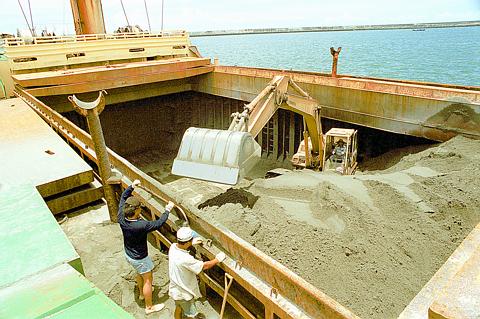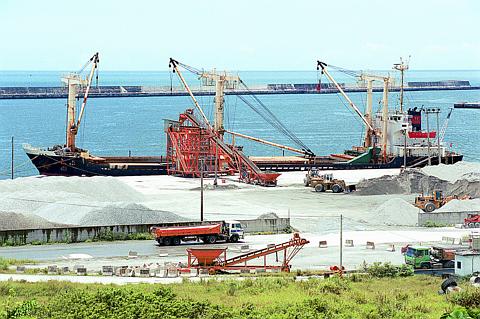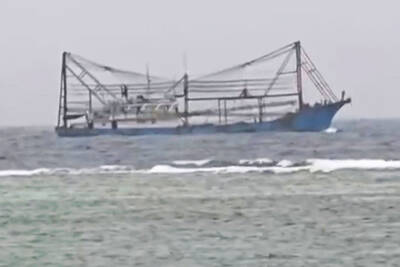Searching for an answer to the fate of the gravel ship Hualien No. 1 that vanished off Taiwan's coast in late February is a complex issue, and one in which evidence is both scant and often contradictory.
No distress signal was received from the vessel's automatic mayday equipment and other safety equipment such as lifeboats have not been located. Search operations have failed to find any bodies, flotsam or even the tell-tale fuel slick that accompanies most tragedies at sea. And neither has any evidence been put forward that would suggest foul play, such as piracy.
But opinions from maritime safety experts, seamen who had previously served on the vessel, experienced masters of ships, and those who said they had spoken to members of the Hualien No.1's crew before the vessel vanished, all seem to lead to the same logical conclusion -- that the ship sank, and did so rapidly.

"Considering the circumstances, the ship must have capsized in the blink of an eye, but nobody knows where it sank," said Chao Yu-seng (趙榆生), a master-mariner-turned lecturer at National Taiwan Ocean University. Chao made the comment last Friday, during a joint discussion of the case with eight maritime experts.
Records that the ship often leaked while sailing, its history as a refitted lumber ship, the rough weather, and the maritime features of Taiwan's northeast coast were all pieces of a jigsaw puzzle that led to a likely, albeit imperfect, picture of the vessel's fate.
Former crew members who had served aboard the vessel agreed with Chao.

PHOTO: GEORGE TSORNG, TAIPEI TIMESN
"Those who used to work on the Hualien No.1 told me that I should not expect the ship to return. They said the ship was in poor condition, and had probably sunk rapidly," said Chang Chih-yun (章志筠), wife of Han Kuo-chi (韓國基), one of the 21 crewmen that disappeared with the vessel on Feb. 28.
When interviewed by the Taipei Times, former seafarers who had first-hand experience aboard the 16-year-old bulk carrier either declined to comment on the vessel's state of health or confirmed Chang's view.
"This ship must have sunk. It's unlikely that it's been hijacked," said Mr. Chiang, who had worked on the vessel for over a year.
Chiang admitted that the vessel leaked and and that crew members often had to repair cracks and plug leaks while the ship was at sea.
"Every now and then the Hualien No. 1 needed repairs. If the hull was leaking, you had to fix it, otherwise the ship would fail its safety inspection," Chiang said.
"But those repairs that were made were not carried out properly. Just so-so would be fine. This is how things work in Taiwan," he said.
A mobile phone conversation between the the ship's apprentice engineer Chen Shun-ching (
"My brother [Chen] told him that the ship had sprung a big hole, and that the crew members were busy fixing it en route," Chen Mei-hua (
Although Yen urged Chen to return to the port of Hualien for safety, he said some of his more senior colleagues were sure everything was OK.
"Then the phone connection was lost and Yen was unable to communicate with my brother," she added.
Ships' Masters-turned lecturers at National Taiwan Ocean University, as well as other experienced seamen, confirmed that crew members working on refitted gravel ships sailing on domestic routes in Taiwan often had to fix cracks and leaks while en route to their destinations.
They said most of the ships in service are second-hand vessels purchased abroad and usually over ten years old. The ageing hulls of such ships are often fragile, and pose a risk of fracturing, especially while sailing amid rough seas, they said.
Less than ship-shape
The fact that the Hualien No. 1 was not a dedicated gravel ship, but rather a refitted lumber vessel, made it all the more dangerous, especially in poor weather, according to marine experts.
Records showed that Hualien No.1 was originally used as a lumber carrier after being built in Japan in 1984, and was refitted as a gravel ship by East Shipping Company in Taiwan.
Although Daniel Cheng (
Jong Tain-chyuan (
"As the ship used to carry lumber in its hold, there is a good chance that the vessel may have become structurally weakened by the constant clashing of lumber against the hull [in rough seas.] Such repetitive stresses increase the likelihood of crack formation, and, therefore, of leaks in the hull," Jong said.
Bruce Lin (林彬), master-mariner-turned associate professor at National Taiwan Ocean University, pointed out the inherent weaknesses of the Hualien No. 1 as a refitted rather than a dedicated gravel ship.
"Because such dedicated gravel ships are equipped with an enhanced double bottom ... the stability of these carriers are much higher than refitted gravel ships such as Hualien No.1 which lack these features," Lin said.
"Strong winds and a rough sea could make the vessel roll wildly and trigger a violent movement of the gravel contained in its hold. Such a vessel could lose its stability on rough seas and even capsize rapidly," he said.
A weather forecast by the Central Weather Bureau showed that strong winds of 7 to 8 on the Beaufort Scale were expected that day, a level approaching gale force. Some gusts were expected to reach as high as 10 on the scale, a level approaching storm force.
Seamen familiar with Hualien No.1's route from the ports of Hualien to Tamsui pointed out some of the shipping route's features.
Based on his four years of experience in sailing gravel ships from Hualien to Keelung and Tamsui, Liu Ching-tai (
"The strong northeasterly monsoon winds can have a great effect here, triggering large waves at sea," Liu told the Taipei Times at Hualien Harbor last Tuesday.
"In addition, the ship normally has to make a very sharp turn towards the northwest near the vicinity of Cape Fukui (
While some were confident the gravel carrier sank taking all 21 lives with her, others had reservations.
East Shipping's Cheng said prima facie evidence that showed the ship did not sink was that no distress signal was received from the vessel's automatic mayday transmitter -- equipment that the ship owners claimed was fully operational.
Apart from lifeboats, the vessel was equipped with VHF radio transmitters, distress flares, and a satellite-signalling device called an Emergency Position Indication Radio Beacon (EPIRB), Cheng said.
In fact, the vessel had passed a safety inspection conducted by the Keelung branch of the China Corporation Register of Shipping (CCRS,
Documents collected by the Taipei Times, including a Cargo Ship Safety Equipment Certificate issued by CCRS on Feb. 14 and a radio station license issued by the Ministry of Transportation and Communications (MOTC), indicated that the missing vessel had these safety kits on board.
But whether the safety equipment would actually remain operational in times of emergency was another story, experts warned.
Although satellite EPIRB works as part of a worldwide distress system which picks up mayday signals 24 hours a day, 365 days a year, and transmits them to the appropriate authorities, nobody can say for sure that the EPIRB on the Hualien No.1 was functional.
The EPIRB may fail to function if it is lashed down, stowed in a sealed room or if its battery is exhausted, said Yeh Shyh-tsann (
The EPIRB device, under normal circumstances, begins transmitting only after it has floated free from a sinking vessel, Yeh said.
Based on his experience of conducting random inspections of EPIRBs aboard vessels, Yeh Ming-shui (
Experienced seamen also said that in times of emergency, crew members that panic often fail to send out a mayday signal.
The fact that search operations failed to find any bodies, wreckage or telltale signs -- such as the fuel oil slick that accompanies most sinking ships -- that left many in doubt that the ship actually sank.
"Even if the ship sank rapidly, there should have been some trace, right?" asked Han's wife, Chang. Even maritime experts admitted there are contradictions that remain unresolved.
"If the ship sank in the vicinity of Tamsui, where many vessels gather simultaneously, it's impossible that the sinking would have gone unwitnessed," said Solomon Chen (陳彥宏), head of the laboratory for maritime safety studies at National Taiwan Ocean University.
Looking in all the wrong places
The most likely location where the ship could have sunk, according to Chen, would be in the vicinity of Suao (
But ironically, it was the area surrounding the outlying island of Kuishan (龜山島), Yilan County, that was the focus of initial search efforts.
Maritime experts have said that bad visibility at sea, inefficient search operations, and swift currents could have been possible factors that led to a fruitless search.
Adding to the enigma is conflicting evidence that has been offered, that suggests two different locations for the ship's disappearance.
Based on records of a mobile phone communication between Han and his friend Hsu Lieh-chun (
But a Chunghwa Telecom record showed that the last cellular base station that received a signal from another crew member, Chu Hsi-chun's (
Although nobody seems to have offered a comprehensive explanation as to the fate of the gravel-carrying vessel, such disappearances are far from uncommon in the shipping world -- perhaps the Hualien No. 1 will one day be the subject of maritime folklore, like many other vessels before it.

A Chinese aircraft carrier group entered Japan’s economic waters over the weekend, before exiting to conduct drills involving fighter jets, the Japanese Ministry of Defense said yesterday. The Liaoning aircraft carrier, two missile destroyers and one fast combat supply ship sailed about 300km southwest of Japan’s easternmost island of Minamitori on Saturday, a ministry statement said. It was the first time a Chinese aircraft carrier had entered that part of Japan’s exclusive economic zone (EEZ), a ministry spokesman said. “We think the Chinese military is trying to improve its operational capability and ability to conduct operations in distant areas,” the spokesman said. China’s growing

Nine retired generals from Taiwan, Japan and the US have been invited to participate in a tabletop exercise hosted by the Taipei School of Economics and Political Science Foundation tomorrow and Wednesday that simulates a potential Chinese invasion of Taiwan in 2030, the foundation said yesterday. The five retired Taiwanese generals would include retired admiral Lee Hsi-min (李喜明), joined by retired US Navy admiral Michael Mullen and former chief of staff of the Japan Self-Defense Forces general Shigeru Iwasaki, it said. The simulation aims to offer strategic insights into regional security and peace in the Taiwan Strait, it added. Foundation chair Huang Huang-hsiung

PUBLIC WARNING: The two students had been tricked into going to Hong Kong for a ‘high-paying’ job, which sent them to a scam center in Cambodia Police warned the public not to trust job advertisements touting high pay abroad following the return of two college students over the weekend who had been trafficked and forced to work at a cyberscam center in Cambodia. The two victims, surnamed Lee (李), 18, and Lin (林), 19, were interviewed by police after landing in Taiwan on Saturday. Taichung’s Chingshui Police Precinct said in a statement yesterday that the two students are good friends, and Lin had suspended her studies after seeing the ad promising good pay to work in Hong Kong. Lee’s grandfather on Thursday reported to police that Lee had sent

A Chinese ship ran aground in stormy weather in shallow waters off a Philippines-controlled island in the disputed South China Sea, prompting Filipino forces to go on alert, Philippine military officials said yesterday. When Philippine forces assessed that the Chinese fishing vessel appeared to have run aground in the shallows east of Thitu Island (Jhongye Island, 中業島) on Saturday due to bad weather, Philippine military and coast guard personnel deployed to provide help, but later saw that the ship had been extricated, Philippine navy regional spokesperson Ellaine Rose Collado said. No other details were immediately available, including if there were injuries among